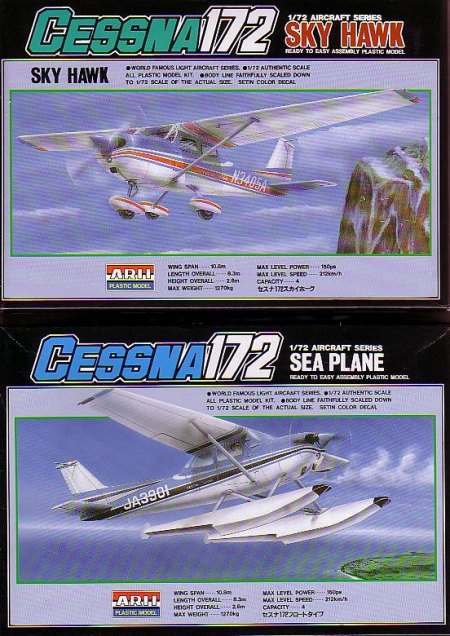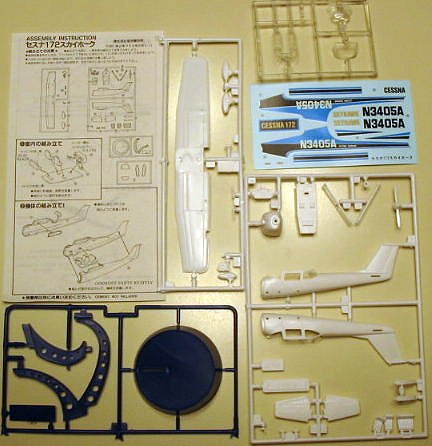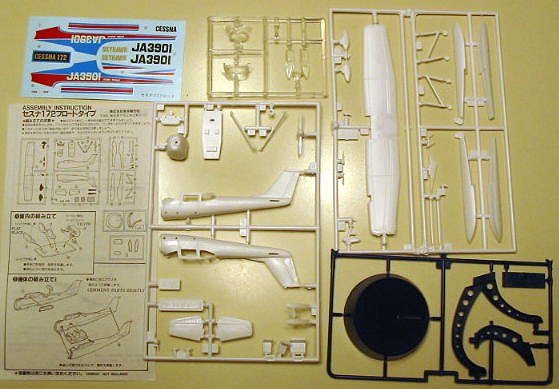
|
KIT: |
Arii 1/72 Cessna 172 Skyhawk |
|
KIT # |
02082 (land), 02085 (floatplane) |
|
PRICE: |
$7.00 |
|
DECALS: |
on option |
|
REVIEWER: |
|
|
NOTES: |
Ex LS kits |

|
HISTORY |
|
THE KITS |
 |
 |
The Cessna 172 sea plane and land plane are two of the models in a series of six light planes from Arii. Also in the series are a Cessna O2-A/Skymaster in both civil and USAF versions, an Aero Subaru, and a Beechcraft Bonanza.
The kits consist of 25 to 30 parts each, molded in white and clear plastic. Also included is a display stand and nameplate, molded in dark blue plastic. In general, the moldings look OK, but with flash on many of the small parts and on the seams of the larger pieces. On the plus side, the fuselage, wing, and floats have recessed panel lines. The lines are not as fine as those found on newer kits, but they do create the effect desired.
The cabin consists of seven parts: floor, instrument panel, seats, and control yokes. Clear parts are provided for the front and rear windscreens and the side windows. There is no detail on the inside of the fuselage in the cabin area. The fuselage is made up from a left and right side, cowl, and prop/spinner. There are a couple of big ejector pins on the inside of the fuselage, one of which is in the cabin area.
The wing is a single piece, with a separate clear piece for the landing light. The panel lines are recessed, with fine recessed lines for the corrugations on the flaps and ailerons.
The sea plane kit includes the parts for the wheeled version as well. The land plane version of the kit does not, however, include floats. So, both kits have the parts for the land plane, but only the sea plane includes the parts for the floats.
The instructions consist of a single small sheet of paper, printed on both sides. Simple pictorial diagrams are provided, with most of the text in Japanese. There are a few colors called out, such as flat black and silver for the cabin interior. The instructions also include general notes such as “Cement parts rightly.” I would definitely check some references before using the painting instructions……!
The decals include all of the fuselage and wing stripes, but not the stripes for the wheel pants. The fuselage decals are quite large, and include the colored sections of the fuselage. Installing and aligning these may be quite a challenge. The registration numbers are integrated with the stripes and color decals. Finding decals to use an alternative color scheme may be difficult. (I expect many builders of these kits would want to do a specific aircraft anyways, so making your own decals may be the only choice.)
The decals and color schemes look to be mixed up between the two kits. The sea plane box art shows an aircraft with Japanese registration numbers (JA3901) with blue and black stripes. The wheeled version of the kit shows a US registration (N3405A), with blue and red stripes.
However, the decals inside the kits do not match the box art. The float plane is JA 3901, but the numbers are integrated with the red and blue color scheme seen on the other box. Conversely, the wheeled N3405A is in the blue/black scheme as seen on the box of the floatplane version. At first you’d think they just mixed up the decals, but that’s not the case, as the registration numbers do match the box art.
|
CONCLUSIONS |
Cautiously recommended. These are the only Cessna 172s available in 1/72 scale that I’ve ever seen in injected molded plastic. The decals may be a challenge to apply, but so does the alternative of trying to paint all those pinstripes.
Models of relatively modern civilian light planes are pretty rare, and the Arii series is probably the largest in terms of subjects covered. It seems unlikely that we’ll see either detail sets for these models, or a releases from another manufacturer, so I say you might as well enjoy these for what they are.
Review kits courtesy of my wallet.
November, 2003.
|
REFERENCES |
If you would like your product reviewed fairly and quickly by a site that has over 200,000 visitors a month, please contact me or see other details in the Note to Contributors.